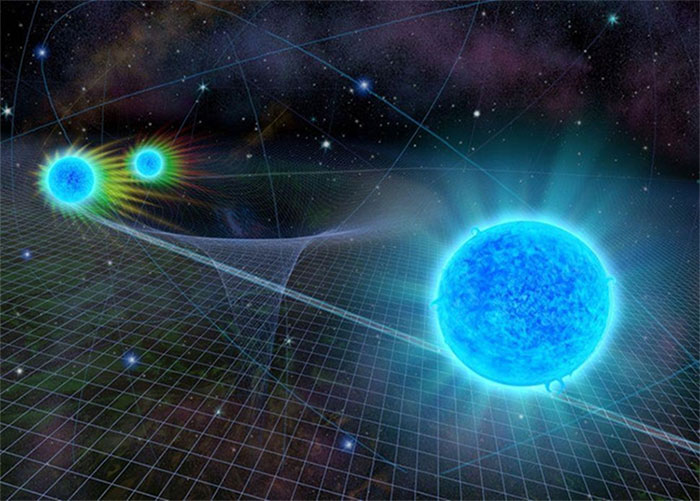Experimental relativity on a super black star, Einstein is right again
By analyzing the gravitational pull of a giant black hole in the center of the Milky Way on a nearby star, astronomers have shown the theory of space and time, describing the gravitational force of Einstein is still correct.
According to Einstein's general theory of relativity, gravity derives from the bending of space and time. The larger the body mass, the stronger the gravitational force.
Scientists largely test general relativity in weak gravitational fields such as the Earth or the Solar System.

The image simulating the star S0-2 when passing through the black hole is located in the center of the Milky Way.When approaching the supermassive black hole, the star has a redshift phenomenon that corresponds to Einstein's theory of relativity.(Photo: National Science Foundation).
In stronger gravitational fields like super black holes (thought to be in the heart of most large galaxies), the researchers found that the involvement of general relativity could give a new theory to explain the The mystery of the universe as dark matter, dark energy.
"Einstein is still right, at least until now," said Andrea Ghez, professor of astronomy at the University of California Los Angeles and co-author of the study.
"Our observations are similar to Einstein's general theory of relativity. However, his theory still has drawbacks. It cannot fully explain the gravitational force in a black hole. At some point, they we have to find a new theory about gravity to explain more clearly what black holes are, " Ghez said.
During the study, astronomers chose the supermassive black hole named Sagittarius A * (Sgr A * for short) , located in the center of the Milky Way, four million times heavier than the Sun with a diameter of about 23. , 6 million km.
Scientists watched S0-2 star from 2018, when it was closest to Sagittarius A * in orbit 16 light years. The closest distance from the star to the black hole is 120 astronomical units (AU) - an AU equivalent to the average distance from the Earth to the Sun (about 150 million km).
Using the Keck Observatory, Gemini Observatory and Subaru Telescope in Hawaii, astronomers tracked the complete trajectory of S0-2 in three dimensions, combining them with measurements 24 years.
The researchers examined a prediction of general relativity called "gravitational redshift" - the color shift of the red light spectrum in a more reddish direction under the force of gravity. .
The results showed that the light spectrum from S0-2 stars shifted to red when passing through the gravitational force from the black hole Sagittarius A *, in accordance with relativity.

Stars orbit around the supermassive black hole in the center of the Milky Way.The yellow circle is S0-2's orbit, the first star has enough information to test Einstein's general theory of relativity around a supermassive black hole.(Photo: UCLA Galactic Center Group).
"These experiments open the door to the ability to test the gravitational nature by taking advantage of the orbits of stars around the supermassive black holes in the center of the Galaxy. This ability has been mentioned for a long time. in theory, but in the end we do it, " said Tuan Do, astrophysicist, University of California Los Angeles.
The study on S0-2 is the first of many studies of the theory of relativity expected to be carried out on the super-star stars of the black hole Sagittarius A *. One of the other stars in the experimental plan is S0-102 with the shortest orbit of nearly 3,000 stars near the supermassive black hole, equivalent to 11.5 years.
Einstein's theory of relativity is true in the universe
- 100 years ago, eclipse turned Einstein into a star
- Proved Einstein's theory of relativity at the galactic level
- Anbert Einstein - The life of the inventor of relativity
- Testing Albert Einstein's theory of relativity on the universe
- Einstein's theory of relativity is true in the universe
- Exhibition of the theory of relativity
- The female student won $ 250,000 thanks to the video explaining the theory of relativity
- Simple understanding of cosmic black holes and gravitational waves
- Catching a super rare scene in the universe: Super giant black hole is swallowing up a star
- How long will it take for you to live outside the universe for 1 year?
- Video explains the theory of special relativity in a fun style
- Two Vietnamese want to review Einstein's Relativity theory
 Van Allen's belt and evidence that the Apollo 11 mission to the Moon was myth
Van Allen's belt and evidence that the Apollo 11 mission to the Moon was myth The levels of civilization in the universe (Kardashev scale)
The levels of civilization in the universe (Kardashev scale) Today Mars, the sun and the Earth are aligned
Today Mars, the sun and the Earth are aligned The Amazon owner announced a secret plan to build a space base for thousands of people
The Amazon owner announced a secret plan to build a space base for thousands of people